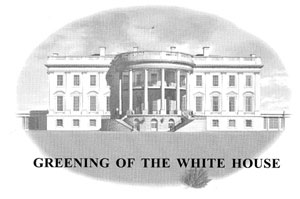Greening the Government
As the country's largest energy user, and its largest consumer of
paper and other products, the United States government has a special
responsibility to act in an environmentally responsible manner. The
government not only leads by example; its enormous purchasing power
helps create new markets for environmentally preferable products, making
them more affordable for everyone.
For President Clinton, this responsibility begins at home: the White
House today is a model of energy efficiency and careful environmental
stewardship. The President has helped spread this ethic throughout the
government. Through a series of executive actions, he has directed all
federal agencies to improve their environmental performance, from using
recycled paper to curbing their use of energy and toxic chemicals.
Apart from their enormous environmental benefits, these measures are
spurring new growth and jobs, and saving federal taxpayers millions
of dollars each year in energy and other costs.
The Greening of the White House
On Earth Day 1993, President Clinton launched a new initiative to
dramatically improve the energy and  environmental performance of the White House complex with steps that
can be taken at any home. Measures implemented include: replacement
of thousands of light bulbs with more efficient compact fluorescents;
installation of hundreds of weather-tight windows; heating and air conditioning
upgrades; an 80 percent reduction in pesticide use; installation of
a water-conserving sprinkler system; and the composting of paper and
trimmings from the White House grounds for use as fertilizer.
environmental performance of the White House complex with steps that
can be taken at any home. Measures implemented include: replacement
of thousands of light bulbs with more efficient compact fluorescents;
installation of hundreds of weather-tight windows; heating and air conditioning
upgrades; an 80 percent reduction in pesticide use; installation of
a water-conserving sprinkler system; and the composting of paper and
trimmings from the White House grounds for use as fertilizer.
A Greening of the White House status report issued last year found
that these steps are saving $300,000 a year and reducing annual greenhouse
gas emissions by 845 metric tons — the equivalent of taking more
than 600 cars off the road. Additional improvements are underway.
Conserving Energy and Taxpayer Dollars
As the nation's single largest energy user, the federal government
spends roughly $8 billion a year to power its vehicles, buildings and
other facilities. Through the Federal Energy Management Program, the
Administration has reduced energy use in federal buildings by more than
12 percent, cutting the government's energy bill by almost $600 million
a year.
Last year, President Clinton issued an Executive Order to produce
far greater savings. The Order directs agencies to reduce energy use
in buildings 35 percent by 2010, and to expand their use of renewable
energy sources such as solar, wind, geothermal, and biomass. Meeting
this goal will reduce annual greenhouse gas emissions by 2.4 million
tons — the equivalent of taking 1.7 million cars off the road —
and save taxpayers over $750 million a year. It also will expand markets
for renewable technologies, reduce air pollution, and serve as a powerful
example to businesses and consumers who can reap substantial benefits
from energy improvements.
Expanding Use of Recycled Products
The federal government purchases more than 20 billion sheets of copier
paper every year. In 1994, only 12 percent of the paper used by the
federal government contained any recycled fiber.
Through two Executive Orders, the President directed federal agencies
to gradually increase their use of recycled-content paper. Last year,
98 percent of the copier paper purchased by federal agencies contained
a minimum of 30 percent post-consumer fiber. This dramatic improvement
is saving up to half a million trees a year, reducing air and water
pollution, and curbing emissions that contribute to global warming.
The President also directed agencies to purchase a wide range of other
recycled products — such as insulation, carpeting, motor oil, and
retread tires — and encouraged them to purchase other environmentally
preferable products whenever possible. Federal purchases of recycled
products grew from $240 million in 1992 to $350 million in 1997.
Reducing Toxic Releases
Many federal agencies use hazardous chemicals, primarily solvents,
in maintaining their facilities and equipment. On Earth Day 1993, the
President issued an Executive Order requiring agencies to report and
to dramatically reduce their releases of toxic chemicals. Specifically,
he mandated a 50 percent reduction in toxic chemical releases in five
years. The agencies, using a variety of pollution prevention strategies,
met the goal in just two years. Some of the most dramatic reductions
were achieved at the Department of Defense, which uses large quantities
of hazardous chemicals to repair and maintain ships, aircraft, and other
military equipment.
The industrial-looking Defense Fuel Support Point may seem an unlikely
haven for butterflies, but the 320-acre depot contains some of the best
remaining habitat for the Palos Verdes blue. When a UCLA biologist doing
research at the depot stumbled across the survivor, the university teamed
up with the Defense Department and the Fish and Wildlife Service to
help bring the species back.
So far, volunteers have put in more than 5,000 hours restoring the
butterflies' coastal sage scrub habitat, and helping raise its population
from 400 to 1,000.
The effort to save the PV blue also is creating a brighter future
for some of the volunteers — a contingent of inner-city kids working
with the Los Angeles Conservation Corps. "I'm saving them from extinction,"
said former gang member Arthur Bonner, "and they're saving me from the
street."

